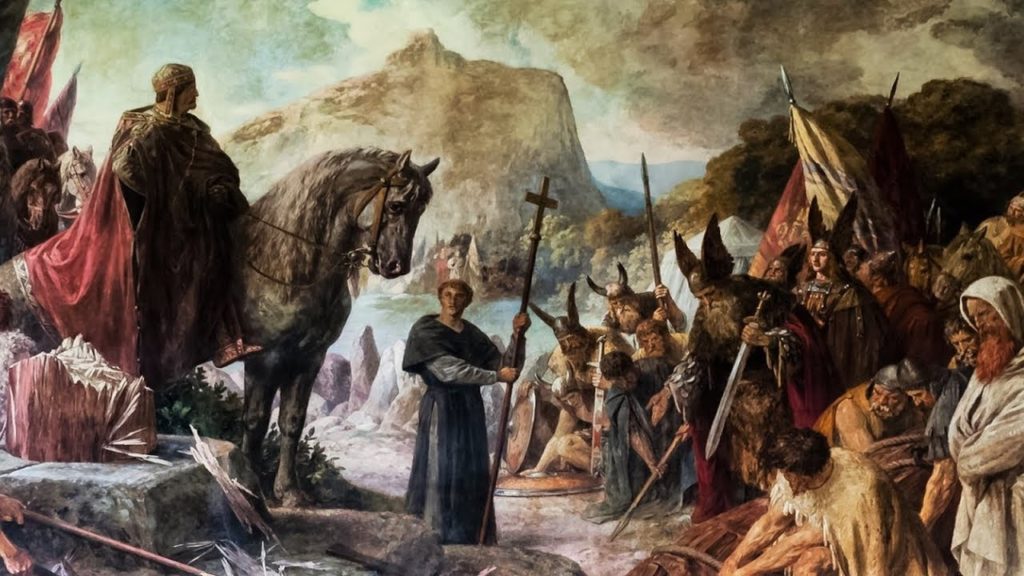The bloody ‘mission’ of the Saxons (772-804)
Desiderius, the last king of the Longobards, went with his wife and daughter, Charles’ ex-wife, to a Frankish prison, then disappeared into a monastery (probably in Corbie), where he still survived for some time. In any case, he disappeared forever. The Longobard kingdom was wiped off the map.
‘Of all the wars Charles fought’, writes Einhard, ‘the first was the Aquitanian… After that war was over… Charles was induced by the entreaties and pleas of [pope] Adrian, bishop of Rome, and declared war on the Longobards… He then resumed the war against the Saxons… uninterrupted for thirty-three years’.
The Saxons, whose name means companions or people of the sword, are first mentioned in the writings of the mathematician, astronomer, and geographer Claudius Ptolemy, who lived in the 2nd century. ‘Without avarice and without excess, quiet and isolated, they do not provoke any war, nor cause devastation by campaigns of plunder’. Their armed raids were carried out by sea and by land: the former in hollowed-out tree trunks, in which they could fit about three dozen men.
Arriving perhaps from Scandinavia, they preferred to settle in coastal areas. For a long time they stayed in the northern part of France, which was called sinus saxonicus (Saxon gulf), and in Flanders, also occupying the Lüneburg territories after the withdrawal of the Lombards. In the mid-5th century a large part of the Saxons moved to England, but the majority remained on the continent, where their kingdom extended throughout what is now northwest Germany, with the exception of the Frisian territories.
Of all the German counties, only the Saxon shires, of which we know more than a hundred by name, remained in the same hands. Less exposed to Roman influences, they also preserved their national identity better than the peoples living further south. And those pagan Saxons had ‘the best laws’, as even the abbot of Fulda, Rudolf, acknowledges. ‘And they strive for many things of profit and in accordance with the natural law they pursue honourable things with the honesty of manners’.
Their name doesn’t comprise a single tribe, but rather an association of tribes (about which researchers argue), to whose formation contributed, in addition to the Saxons, the Angrivarians, the Cheruscans, the Lombards, the Thuringians and the Semnones. Later, the Westphalians, Ostrophalians and Elbe Saxons also joined them. The Franks, however, regarded them as members of a single people and generally called them ‘Saxons’ without further distinction. After their joint conquest of Thuringia with the Franks in 531, they took the eastern part, which still bears their name.
It is probable that the Saxons, too, originally had kings, but no real kingdom or duchy developed among them. Their society consisted of four classes: nobles (nobiles), freemen (liberi), liti and slaves (servi); the ‘liti’ being those bound to the soil, the serfs of the glebe. The lower classes defended themselves against the Christianisation and domination of the Franks, while the nobility sought to safeguard their interests by relying on the enemy of the state.
Elsewhere, too, it was the wealthy class that was the first to convert to Christianity. While, for example, the nobility of Civitas Treverorum in the bishopric of Trier converted at the end of the 4th century, the tenant farmers, serfs and farm labourers remained longer and more stubbornly attached to the old beliefs, converting only in the middle of the 5th century. And also among the Slavs their princes probably preceded their tribes in baptism. According to Flaskamp:
This was the way things went everywhere with officially directed missionary work, there being nothing special about the fact that the Frankish mission developed ‘from the top down’. A ‘democratic’ construction, starting from below, from the socially insignificant popular strata, would have been impossible, for it would have appeared as demagogy and would have been rejected by the nobility.
It can hardly be considered accidental that in the complete change of the situation during the first Christian centuries it was everywhere the ruling class that obtained the greatest advantages from the religion of love.
______ 卐 ______
Editor’s note: Just as in our times it is the elites—Western governments, media and corporations—who push the Woke ideology to the masses. Both in medieval times and now the aim is to subjugate one’s own people through mad ideologies.

One reply on “Christianity’s Criminal History, 162”
The rot trickles down from the top.
The catechism of Charles was the seed that sprouted the christian corruption of the whole Frank kingdom, and later incited bloody wars of conversion against the Saxons. And the Saxon rulers were seduced by promises of power and wealth from the Church.
If a small seed like Charles the Altar Boy can result in such widespread evil, it is of the utmost importance to mentally ‘vaccinate’ nobility-inheriting children against such ideologies of madness.
Just as Hamilcar Barcas filled the mind of young Hannibal with anti-Roman mantras, there should have been pagan druids filling the minds of Frank and Saxon noble youths with anti-Christian hatred.
It would have been a very effective antidote against the trickle-down rot.